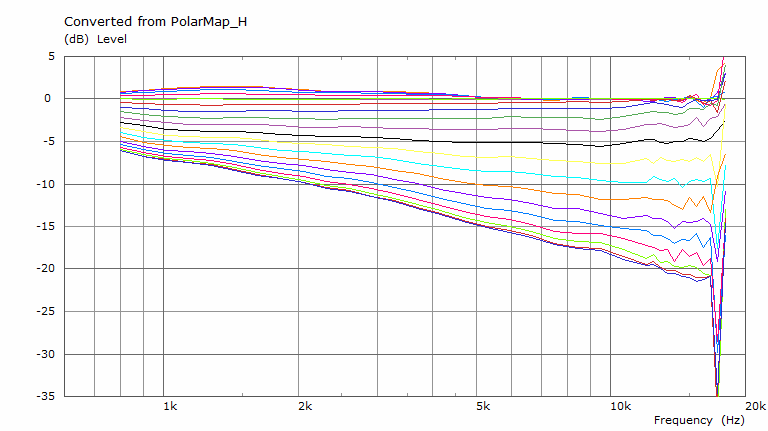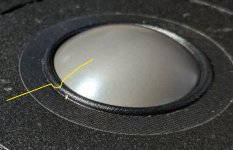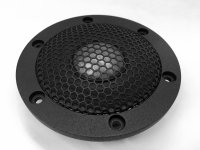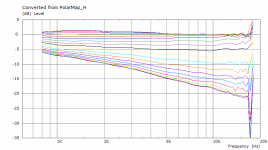What is more interesting is how one takes care of the energy emitted by a surround... you don't want it into the WG. So the WG should start with a very sharp edge to collect the energy form the dome but energy coming from surround should go on the other side? How to digest that energy so not to do harm? Or?
//
//
I didn't have an spl meter at the time but I'm confident that they can peak high enough for any domestic application.
I ran one T34A for several hours outdoors at high PA level spl's(loud enough to shout over at 25m) and it was only slightly warm to the touch in 85 degree weather.
It was crossed to a 98db/w 10" at 2khz LR24.
I ran one T34A for several hours outdoors at high PA level spl's(loud enough to shout over at 25m) and it was only slightly warm to the touch in 85 degree weather.
It was crossed to a 98db/w 10" at 2khz LR24.
Any build threads?
I wonder if either of these could produce 115-118dB at 1m without releasing the magic smoke.
No doubt these are the best dome tweets by a margin.
This is an infinite baffle simulation of T34-B with my best waveguide (throat profile changed to conical) - now this is probably the way to go. Above 16 kHz the results are rubbish.
How would you do to dig a little (-2 or - 3 db) the -circa- 2.8k to 4.5k windows ?
(it will acheive a best tonal balance than a straigt constant directivity there ! (imho, ymmv
That's not really important. What is important is what can be achieved with such a driver - to repeat: 

I haven't seen anything this good before. Now I'm strongly tempted to try this with the DA25TX I have at home (maybe I should have bought the DA32TX instead). Definitely, if someone has these tweeters, they may be quite interested in using them in a waveguide like this.
I haven't seen anything this good before. Now I'm strongly tempted to try this with the DA25TX I have at home (maybe I should have bought the DA32TX instead). Definitely, if someone has these tweeters, they may be quite interested in using them in a waveguide like this.
Last edited:
Yes that's awesome constant directivity, but if not made passivly by the horn I will notch that 2.8k to 4.2K area cause there is no chance it sounds good (to me) with something so flat ! I believe it's clearer the way I express it now. The horn has nothing to do but if it can makes this dip by design not using notch filter for the passive filter fans then it will be AWESOME  (or use a teeter that have already that dip)
(or use a teeter that have already that dip)
I believe there must have been something wrong with the design that lead you to believe that such a dip is a good thing. Maybe a radiated power response issue? I don't believe anyone would prefer a dip in a blind test systematically - not in a loudspeaker as flat (in direct sound AND in power response) as this one would be. I wouldn't do it by design but of course one could do it, passively or actively, it doesn't really matter.
Last edited:
Dunno, but I can describe it : there is a mismatch in tonal balance and an easy way to check it is with real voices. While this range is very focused it will made the voice a little too high and light. Nothing confusing at ears but you notice after a while the voices are not acurate and untimbred ! Which i not surpriing, few cd/horn are well timbred, their atractin is elswhere (that non storage energy  )
)
Anyway it's easy to make onself the experiment with a flat spl tweeter ! I surmise some ears to be more or less sensible to that and the spl dip to be as sensible as 0.5 db (to be experienced to know, for sure, perhaps room dependant as well, I repeat dunno, just achevied with measuring and experiments, very personal setup ! )
Anyway it's easy to make onself the experiment with a flat spl tweeter ! I surmise some ears to be more or less sensible to that and the spl dip to be as sensible as 0.5 db (to be experienced to know, for sure, perhaps room dependant as well, I repeat dunno, just achevied with measuring and experiments, very personal setup ! )
Last edited:
- Home
- Loudspeakers
- Multi-Way
- Acoustic Horn Design – The Easy Way (Ath4)


